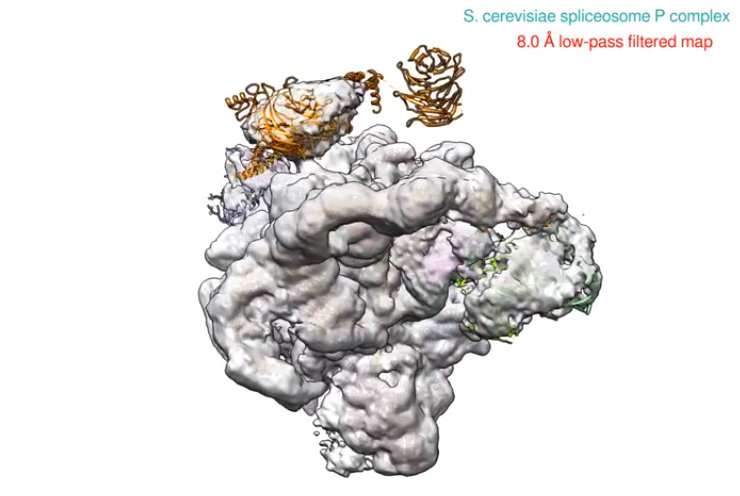UCLA researchers have solved the high-resolution structure of a massive cellular machine, the spliceosome, filling the last major gap in our understanding of the RNA splicing process that was previously unclear.
The cryo electron microscopy (cryoEM) atomic structure of the spliceosome P complex at 3.3 Å resolution has been published in an online article by the journal Science.
DNA contains the blueprint for a cell to operate but the genetic code must be transcribed into RNA to translate the message to the cell. The initial RNA transcript is cluttered with useless or "junk" RNA fragments from our genome called introns that must be removed, or spliced, to convey the right meaning – just as a film editor removes unnecessary footage to create a final cut for theaters. The spliceosome is a huge molecular machine made of 5 small noncoding RNAs and over one hundred proteins that removes introns so that only useful fragments called exons are left behind. These exons are rejoined to create the final messenger RNA that can be translated into protein.
The splicesome changes dramatically as it works. Overall, there are at least 7 forms known that perform specific functions. This discovery has elucidated the P complex, now known in high-resolution detail to be involved in correctly recognizing the RNA to be cut, joining the exons, and releasing the RNA after cutting.
Credit: University of California, Los Angeles
"A lot of progress has been made in our understanding of how the spliceosome works, but one of the biggest challenges remaining was to understand how the exon dissociates from the active site," said co-first author Shiheng Liu, a postdoctoral researcher who works with the study's co-senior author, Z. Hong Zhou, director of the Electron Imaging Center for Nanomachines at the California NanoSystems Institute at UCLA and a professor of microbiology, immunology and molecular genetics.
"There have been many questions related to the unsolved P complex," said Liu. "The entire RNA splicing cycle is better understood by this discovery."
Errors in RNA splicing can cause a large array of human diseases, highlighting the importance of having intricate knowledge of how the spliceosome functions.
More immediately, this research opens the door for targeted biochemical experimentation based on structure. With the atomic models of nearly all major contorts of the splicesome now known, a full mechanistic understanding may soon be available.
More information: Shiheng Liu et al. Structure of the yeast spliceosomal postcatalytic P complex, Science (2017). DOI: 10.1126/science.aar3462
Journal information: Science
Provided by University of California, Los Angeles






















